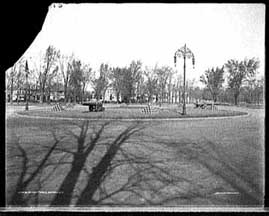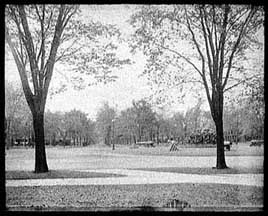
Soldiers Circle - LINKS
...... Bidwell Parkway - LINKS .........Chapin
Parkway - LINKS ....
Olmsted Park and Parkway System - Table of Contents
Soldiers Circle, Bidwell Parkway
and Chapin Parkway
By Benedict R. Maryniak
|
Click on photos for larger size

Soldiers' Circle
Photo taken between 1900 and 1910. Negative cracked upper left. Negative: glass;
8 x 10 in.
Source: Photographs from the Detroit Publishing Company

Bidwell Parkway / Soldiers' Circle
Photo taken between 1900 and 1915. Negative: glass: 8 x 10 in. Soldiers' Circle is
in the rear of the photo.
Source: Photographs from the Detroit Publishing Company.
|
Soldiers Place,
also called Soldiers Circle, forms the central connecting point of Buffalo's
parkway system, designed by Frederick Law Olmsted.
Soldiers Place is the point at which Lincoln, Chapin, and Bidwell Parkways converge.
The parkways in Olmsted's day were smoothly paved and intended solely for use of
private carriages. Featuring 200-foot rights of way and flanked by several rows of
trees, they were designed to provide open space for the neighborhoods through which
they passed.
Soldiers place was originally a very large circle that was meant to hold the likes
of the Soldiers & Sailors monument now gracing Lafayette Square. When the monument
was erected downtown, Soldiers Place received four large naval parrot rifles mounted
on Grand Army of the Republic carriages and accompanied by stacks of cannon balls.
Colonial Circle also had similar guns and projectiles. From the very start, junkmen
found the cannon balls irresistible.
The cannons and ammunition stacks were removed from Soldiers Place in 1937 by Parks
Commissioner Frank A Coon who condemned them as traffic hazards. Motorists would
cut across the street-level circle, sometimes crashing into the massive gun tubes.
Coon argued that the cannons had no historic significance -- the navy had supposedly
condemned the guns without ever putting them into service. Coon had removed the artillery
pieces from Colonial Circle the year before for the same reasons. Everything was
sold for scrap.
As a gesture to mark his leaving the Buffalo City Council (giving the gavel to Peter
J Crotty in 1947) Kneeland B Wilkes used $10,000 of his own money to beautify Soldiers
Place. It had earlier gone to seed due to a lack of Parks Department funds. This
work was done during 1948 and featured a low stone wall and flagstone walk. The circle
was then renovated one more time, getting its current pear trees. In 1998, members
of the immediate neighborhood started an effort to revive Soldiers Place yet again.
Bidwell Parkway:
Daniel Davidson Bidwell was born
during 1819 in Black Rock NY, heir to the lucrative commercial interests of Benjamin
Bidwell, who founded Buffalo's Banta & Bidwell Shipbuilding Company. Active in
Buffalo's pre-war militia and instrumental in organizing the city's first police
force, he helped to raise the 49th NYV and was named its colonel October 21, 1861.
General Meade personally recommended his promotion to brigadier general, which took
effect August 11, 1864. Bidwell was mortally wounded in action October 19, 1864,
at the Battle of Cedar Creek, Virginia. He is buried at Forest
Lawn Cemetery, where there is also a memorial shaft dedicated to him. Bidwell
Parkway and the equestrian statue in Colonial Circle are also dedicated to his memory.
Chapin Parkway:
Another road was named after Brigadier General Edward Payson Chapin, a
native of Waterloo NY who was a well-known Buffalo attorney when the war broke out.
He was also a member of the city's first semi-pro baseball club -- The Niagaras.
In 1861, Chapin became captain of Company A in the 44th NYV, otherwise known as Ellsworth's
Avengers, and rose to the rank of lieutenant colonel after he was wounded at Hanover
Court House, Virginia, on May 27, 1862. Tapped for the colonelcy of Erie County's
116th NYV that September, he actually chose Niagaras teammates to help him command
the regiment -- George M Love as lieutenant colonel and John Higgins
as major. Chapin was killed May 27 at Port Hudson, Louisiana, exactly one year after
his Virginia wounding and appointed a brigadier general on the day he died. He is
buried in Waterloo where he was born.
(Lincoln Parkway was named in honor of Old Abe)
Photos and their arrangement © 2002 Chuck
LaChiusa
| ...Home Page ...| ..Buffalo
Architecture Index...| ..Buffalo History
Index... .|....E-Mail ...|
..
![]()